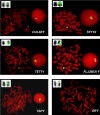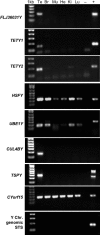Novel gene acquisition on carnivore Y chromosomes
- PMID: 16596168
- PMCID: PMC1420679
- DOI: 10.1371/journal.pgen.0020043
Novel gene acquisition on carnivore Y chromosomes
Abstract
Despite its importance in harboring genes critical for spermatogenesis and male-specific functions, the Y chromosome has been largely excluded as a priority in recent mammalian genome sequencing projects. Only the human and chimpanzee Y chromosomes have been well characterized at the sequence level. This is primarily due to the presumed low overall gene content and highly repetitive nature of the Y chromosome and the ensuing difficulties using a shotgun sequence approach for assembly. Here we used direct cDNA selection to isolate and evaluate the extent of novel Y chromosome gene acquisition in the genome of the domestic cat, a species from a different mammalian superorder than human, chimpanzee, and mouse (currently being sequenced). We discovered four novel Y chromosome genes that do not have functional copies in the finished human male-specific region of the Y or on other mammalian Y chromosomes explored thus far. Two genes are derived from putative autosomal progenitors, and the other two have X chromosome homologs from different evolutionary strata. All four genes were shown to be multicopy and expressed predominantly or exclusively in testes, suggesting that their duplication and specialization for testis function were selected for because they enhance spermatogenesis. Two of these genes have testis-expressed, Y-borne copies in the dog genome as well. The absence of the four newly described genes on other characterized mammalian Y chromosomes demonstrates the gene novelty on this chromosome between mammalian orders, suggesting it harbors many lineage-specific genes that may go undetected by traditional comparative genomic approaches. Specific plans to identify the male-specific genes encoded in the Y chromosome of mammals should be a priority.
Conflict of interest statement
Competing interests. The authors have declared that no competing interests exist.
Figures






References
-
- Lahn B, Page DC. Functional coherence of the human Y chromosome. Science. 1997;278:675–680. - PubMed
-
- Lahn B, Pearson N, Jegalian K. The human Y chromosome, in the light of evolution. Nat Rev Genet. 2001;2:207–216. - PubMed
-
- Tilford CA, Kuroda-Kawaguchi T, Skaletsky H, Rozen S, Brown LG, et al. A physical map of the human Y chromosome. Nature. 2001;409:943–945. - PubMed
-
- Skaletsky H, Kuroda-Kawaguchi T, Minx PJ, Cordum HS, Hillier L, et al. The male specific region of the human Y chromosome is a mosaic of discrete sequence classes. Nature. 2003;423:825–837. - PubMed
-
- Hughes JF, Skaletsky H, Pyntikova T, Minx PJ, Graves T, et al. Conservation of Y-borne genes during human evolution revealed by comparative sequencing in chimpanzee. Nature. 2005;437:101–104. - PubMed
Publication types
MeSH terms
Substances
Grants and funding
LinkOut - more resources
Full Text Sources
Molecular Biology Databases
Miscellaneous

